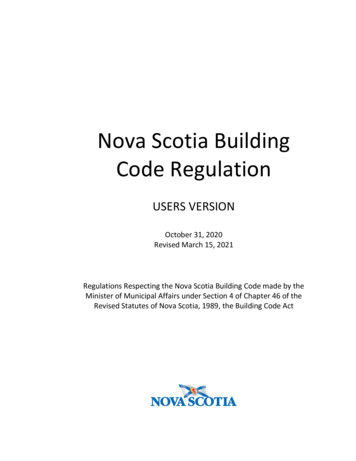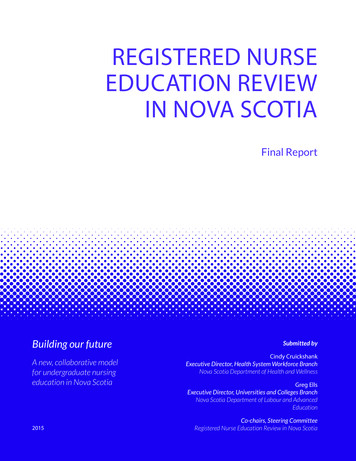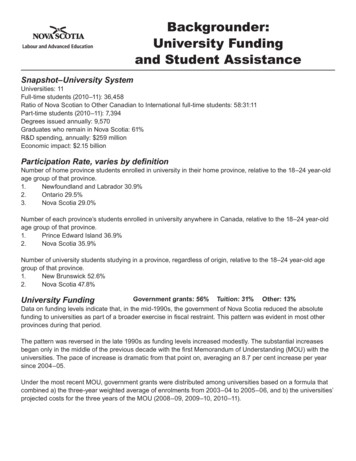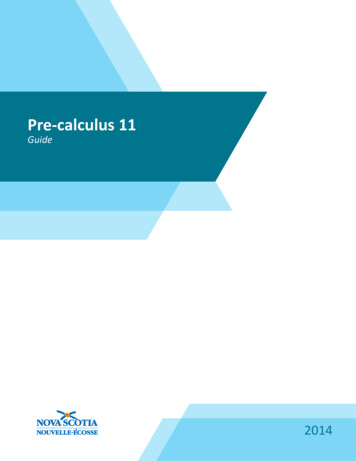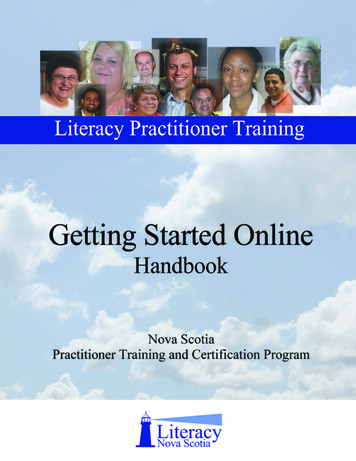
Transcription
Nova Scotia Practitioner Trainingand Certification ProgramPractitioner’s Handbookfor Getting StartedLiteracy Nova ScotiaTruro, Nova Scotia
Copyright 2010 Literacy Nova ScotiaLiteracy Nova ScotiaPO Box 1516Truro NS B2N 5V2Tel.: 902.897.2444Fax: 902.897.4020E-mail: literacyns@nscc.caAll rights reserved. This publication can be reproduced in whole or in part with thewritten permission of Literacy Nova Scotia. To gain this permission, please contact:literacyns@nscc.caThese materials are to be used solely for non-commercial purposes.This publication is available electronically on Literacy Nova Scotia’s website atwww.ns.literacy.ca
AcknowledgementsLiteracy Nova Scotia wishes to acknowledge and thank the following for theircontributions:1)The Office of Literacy and Essential Skills (HRSDC) for funding this project.2)The Department of Labour and Workforce Development, Adult EducationDivision; Nova Scotia Community College; Nova Scotia Provincial Library;National Adult Literacy Database for their support and partnership.3)The members of the Project Work Group who provided valuable input during thedevelopment of the program and the comments and feedback during revisions:4) Allan Banks Avril Lewis Donna MacGillivray Julie Nickerson Catherine WileThe members of the Project Advisory Group who provided valuable advice forthe project and the comments and feedback to complete this report: Ann Marie Downie - Literacy Nova ScotiaMarlene Duckworth – Queens County Learning NetworkPeter Gillis -Valley Community Learning AssociationMeredith Hutchings -Department of Labour and Workforce DevelopmentEarl Letts – National Adult Literacy DatabaseNova Scotia Provincial LibraryDavid Pilmer- Department of Labour and Workforce DevelopmentMel Pothier -Nova Scotia Community CollegeGrail Sangster-Guysborough County Adult Learning AssociationLynne Wells-Orchard- Department of Labour and Workforce Development5)Those who took part in the piloting of the program and provided valuablefeedback: Matt Taylor, Andrea Manthorne, Patricia Cloutier, André Davey,Shannon Davis, Carollynne Nemecek, Hannah Mills, Kirsteen Thompson,Jennifer Steeves, Brenda Lavandier, Donna Casey, Pam O’Neil, Tracey Grosse,Jane Bolivar, Valerie Cheel, Pat Robinson, Sue Balkam, Dale Taylor, BonnieBoivin, Gayle Morrison; as well as their network and regional Adult Educationcoordinators6)The project team – Jayne Hunter, Program Manager; Kate Nonesuch, CurriculumWriter; Elaine Frampton, IT Specialist; and Gary Mason, Pilot Facilitator.
ContentsWelcome .1Goals .1Format .1Requirements .2Frequently Asked Questions .3Description of the Modules .4Orientation: Getting Started Online .7The Practitioner Training Site .7Update your Personal Profile .9Post a new message .10Reply to a message .11Format your message .11Contribute to a Wiki.12Managing your messages .14Literacy, Adult Learners and YOU! .16Adult Literacy Learners .16Adult Literacy Practitioners .17
Welcome to the Nova Scotia PractitionerTraining and Certification ProgramThis is a foundational program for training adult literacy and numeracy practitioners,whether they are paid instructors or volunteer tutors, working in a classroom or one-toone; it is for those who are new to teaching and tutoring, who want to work with adultlearners, and also for people who have experience teaching in the K-12 system or withsecond language learners who want to transfer their skills to working with adult literacylearners. Participants who successfully complete the program will be granted a certificateby the Nova Scotia Department of Labour and Workforce Development.Goals of the programAs you work through the modules of the training program, we hope you will: recognize and value the strengths you already have to bring to your work withadult learners, and take the opportunities provided to develop more strengths inother areas make connections with other literacy practitioners in your area and around theprovince broaden your knowledge of the Nova Scotia School of Adult Learning learn specific teaching techniques and strategies for working with learners come to see the many separate aspects of being a literacy practitioner, andunderstand how they weave together to make an organic whole experience a model of teaching and assessment that you can transfer to your workwith adult literacy learnersFormat of the programThere are nine modules in the program, plus a short practicum. One of them, (―What’sYour Message? Relating to the Adult Learner‖) is delivered in a workshop format,approximately five hours long. The other eight modules are delivered online, with afacilitator. Each of them requires about eight hours to complete, spread over four weeks.This includes linking to sites on the internet, reading, taking part in online discussionswith other participants, doing online activities, and completing assignments. Each moduleincludes one assignment; when the assignment is successfully completed, credit for themodule is granted.Practitioner’s Handbook for Getting Started1
Program RequirementsIt is strongly recommended that all practitioners, especially if they are new to the field,start by taking the module called ―Literacy, Adult Learners and YOU!‖ Other modulesmay be taken in any order.To obtain the certificate, practitioners must successfully complete a practicum plus sixmodules, as follows:1. ALL of these three modules: Literacy, Adult Learners and YOU! What’s Your Message? Relating to the Adult Learner Integrating Information Technology (IT) Skills Into Your Teaching2. ONE of these three modules: The Beginning Reader: Basics Techniques for Teaching Reading, Writing and Spelling Communications: Learners in Transition3. ANY TWO other modules:2 Teaching Math: Basic Principles Teaching Math: Keeping It Real Learning Challenges Or, more of the options given in number 2, abovePractitioner’s Handbook for Getting Started
Frequently Asked QuestionsWhat if I’m not sure my computer skills are good enough totake an online course?The orientation, ―Getting Started Online‖ is made for you. It will introduce you to the siteyou will work on for each module. Besides a written manual and some independent work,a facilitator and a technician will offer to walk you through it by phone or in person, andmake sure you know how to manage the site, how to post messages to the coursefacilitator and other participants, and how to keep track of the material.How long does the program take?You may take the modules as quickly as they are available, if you wish, and complete theprogram in six months or less, or you may take breaks between modules and take up totwo years to complete the program.Can I take more than six modules?Yes. You will be granted a certificate as soon as you complete the requirements of theprogram, but you may go on to take more modules as you wish.What about non-teaching staff?Coordinators, supervisors, other administrators, receptionists, board members and so onwill benefit from the following modules, and could take them as a matter of professionaldevelopment: ―Literacy, Adult Learners and YOU!‖ and ―Learning Challenges.‖Practitioner’s Handbook for Getting Started3
Description of Modules and PracticumOrientation: Getting Started OnlineThe on-line orientation will introduce you to the website for the program; orientationactivities will ensure that you can navigate the site and read and post messages to thefacilitator and other participants. Your facilitator and computer technician will beavailable by phone if necessary. The orientation activities may take less than hour if youare very comfortable with e-mail and other software, or a couple of hours if you havemore to learn.Literacy, Adult Learners and YOU!Who are the adults who come back to school to do the basics? You’ll meet some in print,in video and in person. You’ll broaden your knowledge of the Nova Scotia School ofAdult Learning, and the programs and resources it offers, as well as taking a look at adultliteracy through the lens of Literacy Nova Scotia. Finally, you’ll think about yourself as apractitioner. What do you have to offer? What do you need to develop? What are the joysand satisfactions that come with working with learners in the adult learning program? Isthis the place for you?What’s Your Message? Relating to the Adult LearnerThis module is a one-day workshop, delivered at various places in Nova Scotia. It putsyou in the same room with your facilitator and other practitioners taking the course.Relationships with learners are carried on in complex situations—often in public, each ofyou with assumptions and expectations, and both of you pressured by time and the needto cover content. You will spend the day looking at some common scenarios that happenbetween adult learners and instructors and tutors. You will learn some techniques you canuse to make your relationships with learners less difficult, so you can do what you reallycame for—teaching and learning.We’ll let you know when and where it is offered, so you can pick the one you want toattend.Integrating Information Technology (IT) Skills into YourTeachingThere is more variety now in teaching reading and math because of the resources you’llfind on the internet, and because of new computer programs designed to help learnerswith the subjects. Learners also use and want to learn to use the internet and everydaysoftware to keep up with friends, to look for information, to share photos, to write, toorganize a family tree, etc. You may be very new to this technology or an old hand, butyou’ll find a richness of resources in this module, and a chance to think about some of theissues that come with the technology.4Practitioner’s Handbook for Getting Started
The Beginning Reader: BasicsIn this module, videos of tutors and instructors working with beginning readers are usedto illustrate some of the principles of teaching the skills of reading, writing, listening andspeaking, with an emphasis on using those skills in a real-life situation. Some specificteaching techniques are introduced.This module is recommended for practitioners working with learners in Levels I and II.Techniques for Teaching Reading, Writing and SpellingHow do we teach these basic skills? How do we ―mark‖ learner writing? How can weimprove skills and self confidence at the same time? Some very specific techniques andstrategies are introduced in this module to get you started, or to supplement the work youalready do.This module is recommended for practitioners working with learners in Levels I and II.Communications: Learners in TransitionThe learner who is making a transition to further education or training needs to take allthe communications skills s/he has learned and apply them to ever more academic, moreabstract, more complex reading material and writing assignments. The skills are thesame, but suddenly the newspaper story becomes a biology text book and the languageexperience story becomes a five paragraph essay with a very strict form!This module is recommended for practitioners working with learners in Levels II and IIIwho are planning to go on to higher levels of the adult learning program, or to othertraining, or to take the GED.Teaching Math: Basic PrinciplesWhat’s current in teaching basic math to adult learners? How can I help learners developthe ability to do mental math? How can I help them remember facts and processesautomatically? How can I deal with learner resistance? This module uses content fromLevels I – III and the GED to illustrate some techniques and strategies for teaching, usingmanipulatives, games, models, diagrams, and print and internet resources.Teaching Math: Keeping It RealTopics in this module include developing number sense, using real life applications ofmath, finding and sharing links to interactive online sites for learners, marking forconfidence and test preparation. It uses content from Levels I – III and the GED toillustrate some techniques and strategies for teachingLearning ChallengesLearners in the Adult Learning Program face many challenges—learning difficulties,experiences of violence or trauma, physical and mental health issues, lack of money,Practitioner’s Handbook for Getting Started5
family responsibilities Our focus in this module is on how practitioners can teach sothat learners can deal with the challenges and achieve their educational goals. We will seethat we don’t need a different kind of teaching program or a different set of strategies todeal with each kind of challenge. Rather, teaching practices that support learners toovercome one challenge have a lot in common with strategies to support their efforts toovercome other challenges.The PracticumIt is expected that after the first module, ―Literacy, Adult Learners and YOU!‖participants in the program will be working with a learner or a group of learners. Many ofthe modules include an assignment or activity that asks participants to try something outwith a learner. If you are not working with a learner at the time of taking a particularmodule, alternative activities are provided.At any time after taking ―Literacy, Adult Learners and YOU!‖ a participant in theprogram may complete the ―floating assignment,‖ which consists of planning a sessionwith a learner, carrying it out, and reflecting on the experience, with the help of a mentorwho is an experienced practitioner. This assignment will complete the practicum.The certificate will not be awarded until the practicum is completed.6Practitioner’s Handbook for Getting Started
Orientation: Getting Started OnlineDownload Adobe Reader and Adobe Flash PlayerYou will need these programs to participate in this and other modules.To download these programs free, go to http://www.adobe.com/ and, click on the buttonmarked ―Get Adobe Reader.‖ Follow the instructions on your screen.When the download is complete, return to http://www.adobe.com/ and click on the buttonmarked ―Get Adobe Flash Player.‖The Practitioner Training SiteThe website for the practitioner training course is the Literacy Nova Scotia e-campus, athttp://ecampus.ns.literacy.ca/. Most people like to bookmark that site, so they can getback to it easily. To begin a module, you will need a user account, and, the first time youlog in to a module you will need the enrollment key sent to you by Literacy Nova Scotia.Get a user accountIf you already have a user account on the e-campus, skip this step. If you do not have auser account, go to http://ecampus.ns.literacy.ca/, where you will see ―Click here towatch a video tutorial on how to create a user account on e-campus.‖ Click and followthe instructions.Practitioner’s Handbook for Getting Started7
Get into the moduleGo to the e-campus (http://alt.ns.literacy.ca/). Log on the site by putting in your username and password. Then click on Practitioner Training Course and click on the name ofyour module.Enter the four digit enrollment key you received from Literacy Nova Scotia, and you areinto the module. You will not need to enter that code again—every time you log into thesite, all the courses you are currently registered in will be open to you.8Practitioner’s Handbook for Getting Started
Update Your Personal ProfileOn the main page of the module, look at the second box in the left hand column, marked―People.‖ Click on ―Participants‖ and a list of names will open up. Click on your name,and your profile will appear. Click on the second tab, marked ―Edit profile.‖There are three parts to editing your profile: first, some personal information andpreferences; second, your bio; and, third, your photo. You can work on each partseparately, but in order to save your work, you must scroll all the way to the bottom ofthe page and click on ―Update profile.‖ Until you have clicked ―Update profile,‖ do notclose the panel or use the ―back‖ button, or you will lose the work you have done.Personal PreferencesWhen you click on the second tab, ―Edit profile,‖ you will see a section (―General‖)which includes a set of questions; type your answers in the space provided. Questionsmarked with a red asterisk (*) are required. Save your work by scrolling to the bottom ofthe page and clicking on ―Update profile.‖At the top right of your screen you can show/hide ―advanced.‖ If you click on the word―advanced‖ you will get a longer list which includes settings about your preferences.Many people find it useful to check ―Yes,‖ under forum tracking, so that they can easilysee what’s new when they return to the site.Your BioAt the bottom of the ―General‖ section, there is a box for your description of yourself, sogive us a brief bio. Please give the name and location of the ALP program you areassociated with, and tell us about your involvement in literacy. You may want tocompose your bio in a word processing program, then copy and paste it into the box.There is a separate box (optional) for your interests. Save your work by scrolling to thebottom of the page and clicking on ―Update profile.‖Your PhotoThe next section is for your picture. This picture must be stored on your computer, and beno more than 8 MB in size. Click on the ―Browse‖ button and find the picture file onyour computer. Click on the file name, then on ―Open‖ in the same window. If you arenot sure how to get a photo of yourself onto your computer, ask someone with a digitalcamera to take a picture and show you how to save it to your computer, or ask for help.Save your work by scrolling to the bottom of the page and clicking on ―Update profile.‖Practitioner’s Handbook for Getting Started9
Post a New MessageUse the “breadcrumbs” (scroll down to the bottom of the page) and click on“forums.” Click on the name of the forum you want to post a message to. When thescreen changes, you will see a grey bar that says, ―Add a new discussion topic.‖ Click onthat bar, and write your message in the box that appears. Take some care with writing thesubject of your message. It should give readers a clear idea of what your message is, anddifferentiate it from other topics in the same forum.When you have finished typing, scroll down to the bottom of the page and click on“Post to forum.” Remember, if you close the message form or use the “back” buttonbefore posting, you will lose everything you have written! For this reason, you may wishto compose and save your message in a word processing program, then copy and paste itinto the message form when it is finished.As your message gets longer, another scroll bar will appear on the right of the page.This makes two scroll bars. The scroll bar on the far right controls the whole page. Use it10 Practitioner’s Handbook for Getting Started
to scroll to the bottom to post your message. The other scroll bar, to the left of the onewe’ve just talked about, lets you move up and down in your message only.When you are finished your message, scroll down to the bottom of the page andclick “Post to forum.” You will see a message that you will have 30 minutes to edit yourmessage, or delete it, before it is posted to the forum. (This allows for sober secondthought.) Click ―Continue,‖ and you will see your message as it will appear in the forum.You can click on ―delete‖ to make your message disappear before anyone sees it. If youwant to make changes to your message, click on ―edit,‖ and make any changes you want.Then scroll to the bottom of the page and click on ―save changes.‖ Once again, you willhave 30 minutes to edit your message before it appears for all to see.Note to prevent “lost” messages: When composing in Moodle, it’s important toremember that if you close the message form or use the ―back‖ button before clicking on―Post to forum,‖ you will lose everything you have written! To prevent this, many peoplelike to compose and save their messages in a word processing program, then copy andpaste them into Moodle’s message form. Then if the worst happens and their message islost before it is saved, they still have the original in their word processing program, anddon’t have to start all over again. Others compose right in the Moodle reply form, but ifthey have to backtrack for any reason before they post, they select and copy what theyhave written so far, then they can leave the screen, and when they come back, themessage form will be blank, but they can paste in their message and carry on.Reply to a MessageIf you wish to reply to a message, look at the bottom right corner of the message andclick on the word ―Reply.‖ A new box will open up below the message. Type your replyhere, and scroll down to the bottom of the page and click on ―Post to forum.‖ Remember,if you close the message form or use the ―back‖ button before posting, you will loseeverything you have written! After you click ―Post to forum‖ and ―Continue,’ you willhave 30 minutes to delete to edit your reply, just as when you post a new message.Format your MessageYou will find formatting buttons in the panel at the top of the text box, which willallow you to use color, emoticons and other styles.To insert an “emoticon,” click on the smiley face, and then choose the emotion you’dlike to show, and click on it. Emoticons are useful to show how you are feeling aboutPractitioner’s Handbook for Getting Started 11
what you are writing, because you can’t show your feelings by your tone of voice or bodylanguage, which you would naturally do if you were meeting in person. Especially usefulif you are joking.The two buttons that let you use color can be useful to highlight parts of your message, orto quote from the previous message. Click on the large T with the box of colors to formatthe color of the font; click on the pail with the box of colors to shade in the background tothe text.Cool!Contribute to a WikiClick on the link in the module to connect to the wiki. When you want to add somethingto it, click on the tab marked ―Edit,‖ then click in the spot where you want to addsomething, and type in your contribution.Scroll to the bottom and click on ―Preview.‖ You will get a chance to see what yourcontribution will look like. If you like what you see, click on ―Save.‖ If it’s not quiteright, click on ―Cancel‖ and try again.If you leave the page before you click ―Save,‖ all your changes will be lost.12 Practitioner’s Handbook for Getting Started
Refresh Your ScreenWhen you open a forum, the screen will remain static until you close it. When you openit again, it will show any changes you may have made, for example to your profile or toyour settings, or to show posts you have read.If you would like these changes to show without closing the forum and opening it again,you can click on the Refresh button on the tool bar on your web browser, as shown here.Refresh button in Internet Explorer browser on a PC computerRefresh button in Mozilla Firefox browser on a Mac computerPractitioner’s Handbook for Getting Started 13
Managing your MessagesEmail notification of new posts: If you subscribe to email notification, every timesomeone posts a message in the forum, you will get a copy of the message at your regularemail address.This may be useful because it reminds you to check the Moodle site whenever somethinghas changed. Also, you can flag messages in your e-mail that you want to come back tolater, so you don’t have to search the whole Moodle site looking for that message youwanted to reply to.However, you may find that you don’t want to get copies of these messages in your email, that you would rather check the Moodle site when you have time to pay attention tothe messages.You can choose to subscribe or unsubscribe to all the messages in your course at once, oryou can choose on a forum-by-forum basis.14 Practitioner’s Handbook for Getting Started
Keep Track of Unread MessagesThe Moodle site will keep track of which message you have not yet read.To choose this option, open any forum. You will get a screen that looks like the oneshown here.If you would like have unread posts marked, click on the words ―Track Unread Posts.‖Practitioner’s Handbook for Getting Started 15
Literacy, Adult Learners and YOU!Adult Literacy LearnersWho are adult learners?Adult literacy learners do not fit a specific stereotype. Although they share the samepurpose (enhancing their literacy skills) in returning to education, their motives and goalscan be as diverse as their backgrounds. They may be male or female, of any age; theymay be single, married, living common-law or divorced; they may be parents orgrandparents. They may come from a lower, middle or upper class background andcurrently be employed, unemployed, retired, or disabled.They may be high school graduates who have managed to move through the educationalsystem without actually gaining the necessary skills. They may have dropped out ofschool voluntarily to work, to travel, to start a family, or because they were frustratedwith the system. They may have been forced to leave school.Their reasons for seeking literacy upgrading may be purely personal (to help theirchildren with homework, to read or write letters, etc.), as a requirement for furthereducational attainment (community college, university, etc.), as a condition of present orfuture employment, or as a result of their status in the justice system (e.g., awaitingsentencing, on parole, or fighting for child custody).What are some characteristics of adult learners?There are specific characteristics that all adult learners bring to a literacy program. Theseinclude: a wealth of life experience the choice to attend voluntarily (in most cases) lives full of other responsibilities the memories of good and bad learning experiences an understanding of why they have come to the literacy program goals (which may not be the same as the goals of the program) a desire to be treated with respect, in an environment where they feel safe,comfortable, and supported a need for relevancy and practicality in the course material, combined with a goodsystem of assessment and positive feedback the hope that they will be successfulIn the development of any program, one-on-one or group, these characteristics must betaken into consideration and used as guidelines. Learners may well drop out of a program16 Practitioner’s Handbook for Getting Started
where they feel misunderstood or where they think that their needs and desires are nottaken seriously.What barriers do adult learners face?There are many barriers that adult learners may face while trying to access and attendliteracy programs. Two of the biggest are time and money. Learners who are involved inNova Scotia’s seasonal industries, farming and fishing, may be required to work for adefined period of time in order to maintain their social benefits for the rest of the year.This may mean that they cannot attend classes that require attendance throughout theschool year.The location of programs and transportation can prevent people from attending programs,especially in rural areas of the province. Many learners do not have their owntransportation; they may make arrangements to get a ride with other learners or withfamily members, but if that transportation plan falls through, they are left with no ride toschool. Learners with a physical disability might need special forms of transportation, ormight find the location of the program is not accessible physically.An individual’s family may play a negative role in their acquisition of literacy skills.Other members of the family may feel that returning to education is a waste of time,especially if it takes the learner away from work, or from responsibilities for caring forchildren or other dependents.Emotional factors may make people hesitate to sign up, and reluctant to attend or takepart. Low self esteem and a lack of confidence in their ability to complete the programmay prevent them from throwing themselves into the work. They may fear the programwill result in a repetition of their previous failed attempts at school. They may overestimate their own abilities, and/or be unaware of the breadth and depth of skills peoplewith higher levels of literacy use and enjoy, and so expect to gain those skills morequickly than is likely to happen. Frustration and disappointment can result when thoseexpectations do not materialize.Adult Literacy PractitionersWhat are the roles and responsibilities of literacy practitioners?Tutors and instructors are the core of community learning programs, and are ultimatelyresponsible for the quality and success of those programs. These are some of their keyroles and responsib
Division; Nova Scotia Community College; Nova Scotia Provincial Library; National Adult Literacy Database for their support and partnership. 3) The members of the Project Work Group who provided valuable input during the development of the program and the comments and feedback during revisions: Allan Banks Avril Lewis


